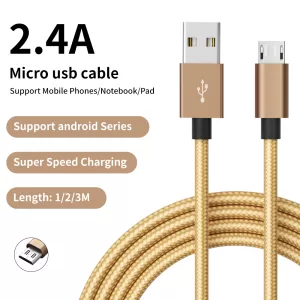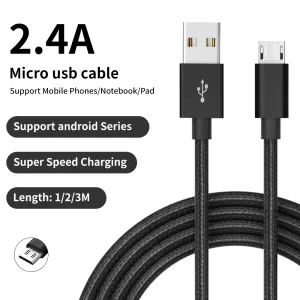Time:2024-10-22 Views:949
The evolution of technology is relentless, and what was once considered cutting-edge can quickly become outdated. Micro USB cables were once the standard for charging and data transfer for many mobile devices. However, with the rapid adoption of newer standards such as USB-C, many wonder if micro USB cables are now obsolete. In this article, we will explore the current relevance of micro USB cables, their advantages and disadvantages, and whether they still have a place in the modern world of technology.
Micro USB was introduced in 2007 as a smaller and more compact alternative to the previous mini USB standard. At the time, it was a revolutionary step for mobile devices, offering a more portable design and universal compatibility across various gadgets, including smartphones, tablets, cameras, and portable hard drives. Micro USB quickly became the industry standard for many electronics manufacturers, replacing proprietary chargers and connectors with a uniform solution that worked across different brands.
For over a decade, micro USB cables were the dominant charging and data transfer method for Android devices, Bluetooth speakers, power banks, and more. However, as technology has progressed, new alternatives have emerged, posing the question of whether micro USB still holds its relevance.

USB-C, introduced in 2014, has rapidly become the preferred standard for many modern devices. It offers several key advantages over micro USB, including faster charging speeds, higher data transfer rates, and the ability to transmit video signals. Moreover, USB-C is reversible, meaning users no longer have to struggle with plugging the cable in the correct orientation—a common frustration with micro USB.
Because of its versatility, USB-C has been adopted by major smartphone manufacturers, laptops, and even gaming consoles like the Nintendo Switch. Its ability to support a wide range of devices and peripherals has made it the preferred choice for consumers and manufacturers alike.
Reversible Design: USB-C connectors can be plugged in either way, eliminating the inconvenience of aligning the cable correctly—an issue often encountered with micro USB.
Faster Data Transfer: USB-C supports faster data transfer rates, up to 10Gbps (USB 3.1), compared to the 480Mbps maximum speed of micro USB (USB 2.0).
Power Delivery: USB-C can deliver significantly more power than micro USB, with support for up to 100 watts of power delivery. This makes it suitable for charging larger devices like laptops, while micro USB is limited to smaller devices.
Video Output: Unlike micro USB, USB-C can transmit video signals, making it compatible with monitors and other display devices. This allows for a single cable to handle multiple functions, such as charging, data transfer, and video output.
Given these clear advantages, it’s easy to see why USB-C is quickly replacing micro USB in many applications.
Despite the widespread adoption of USB-C, micro USB cables are not entirely obsolete. They are still widely used in various devices and markets, particularly in the following areas:
Budget Devices: Many low-cost devices, particularly entry-level smartphones, budget tablets, and Bluetooth accessories, still rely on micro USB for charging and data transfer. Manufacturers often choose micro USB to keep costs down and maintain compatibility with older devices.
Legacy Devices: Consumers who own older electronics, such as smartphones, e-readers, and cameras, may still use micro USB cables to charge or transfer data. These devices continue to function perfectly well, and replacing them just to upgrade to USB-C is not always necessary.
Niche Applications: Some specialized electronics, such as certain types of power banks, IoT devices, and drones, continue to use micro USB connectors. These products may not require the higher performance offered by USB-C, and micro USB remains a viable option for them.

While micro USB is still in use, the transition to USB-C is gaining momentum. Most new devices, especially premium smartphones, tablets, and laptops, have made the switch to USB-C. The European Union has even passed regulations mandating the use of USB-C for all electronic devices sold within its borders, further accelerating the transition away from micro USB.
The shift to USB-C is not just about convenience or speed; it’s also about standardization. By consolidating different types of connectors into a single standard, USB-C simplifies the user experience and reduces electronic waste. Consumers no longer need multiple types of chargers for different devices, which contributes to a more environmentally friendly approach.
For most consumers, the answer is yes. If you are purchasing a new device, especially a smartphone or laptop, it’s highly likely that it will come equipped with USB-C. As more manufacturers embrace this standard, USB-C will become even more prevalent, leaving micro USB behind in the realm of legacy technology.
However, this does not mean that micro USB cables are entirely obsolete. They continue to serve a purpose for those with older devices, and in certain markets where cost is a significant factor, micro USB remains relevant. But as time goes on, its presence will diminish, and USB-C will become the universal connector for most electronics.
For consumers who still own micro USB devices, there is no immediate need to replace them unless their devices no longer meet their needs. Micro USB cables are still readily available and affordable, and many devices can continue to function for years without issue. That said, investing in USB-C cables and adapters is a wise move for those looking to future-proof their charging and connectivity needs.
In some cases, users may choose to upgrade to USB-C adapters or hubs that allow them to connect older micro USB devices to newer USB-C ports. These adapters are inexpensive and can extend the life of older equipment, making the transition smoother.

While micro USB is not entirely obsolete, its dominance in the electronics market is clearly waning. The superior capabilities of USB-C, combined with its adoption by major manufacturers and regulatory bodies, mean that USB-C is quickly becoming the new universal standard.
However, micro USB continues to have its place, especially in budget and legacy devices. For consumers and manufacturers alike, the transition to USB-C is inevitable, but micro USB will likely remain in the market for a while longer, particularly in areas where cost savings and backward compatibility are key.
As technology continues to evolve, it’s only a matter of time before micro USB fades into obscurity, joining the ranks of other once-popular standards that were eventually replaced. Until then, micro USB cables will still be found in homes, offices, and stores, serving as a reminder of how far we’ve come in the world of connectivity.